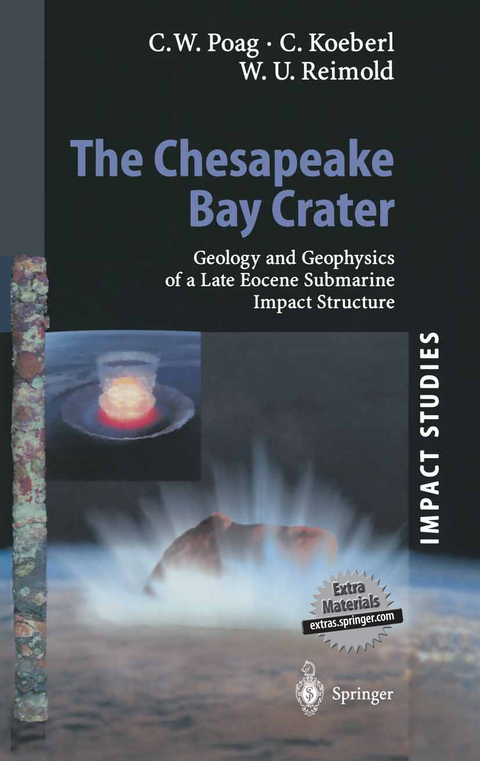
The Chesapeake Bay Crater
Springer Berlin (Verlag)
978-3-540-40441-5 (ISBN)
1 Introduction.- 2 Geological Framework of Impact Site.- 2.1 Crystalline Basement Rocks.- 2.2 Coastal Plain Sedimentary Rocks.- 2.3 Sequence Stratigraphy.- 2.4 Paleogeography of Impact Site.- 2.5 Subsidence of Virginia Continental Margin.- 2.6 Initial Evidence of East Coast Impact.- 2.7 Onshore Borehole Evidence.- 3 Geophysical Framework of Impact Site.- 3.1 Seismic Investigations of Virginia Coastal Plain.- 3.2 Seismic Signature of Crystalline Basement Rocks.- 3.3 Chesapeake Bay Seismic Reflection Profiles.- 3.4 Depth Conversion of Seismic Two-way Traveltimes.- 3.5 Gravity Evidence.- 4 The Primary Crater.- 4.1 Crater Structure and Morphology.- 5 Secondary Craters.- 5.1 Location and Identification.- 5.2 Secondary Craters on Profile T-1-CB.- 5.3 Secondary Craters on Profile T-11-PR.- 5.4 Implications of Secondary Crater Record.- 6 Synimpact Crater-Fill Deposits.- 6.1 Oldest Breccia Unit.- 6.2 Displaced Megablocks.- 6.3 The Exmore Breccia.- 7 Initial Postimpact Deposits.- 7.1 Depositional Setting.- 7.2 Dead Zone.- 7.3 Chickahominy Formation.- 8 Age of Chesapeake Bay Impact Crater.- 8.1 Biochronology.- 8.2 Radiometric Chronology.- 8.3 Magnetochronology.- 8.4 Correlation with Other Craters and Impactites.- 9 Geological Consequences of Chesapeake Bay Impact.- 9.1 General Nature of Consequences.- 9.2 Reconfigured Basement Structure and Morphology.- 9.3 Disruption of Preimpact Sedimentary Column.- 9.4 Source of North AmericanTektite Strewn Field.- 9.5 Far-Field Seismic Effects.- 10 Comparisons with Other Impact Craters.- 10.1 Terrestrial Craters.- 10.2 Extraterrestrial Craters.- 10.3 Comparison with Chicxulub Multiring Impact Basin.- 11 Comparisons Between Impactites.- 11.1 Terrestrial Impactites.- 11.2 Flowin, Fallout, and Dead Zone.- 11.3 Other Intrabreccia Bodies.- 11.4 Continuous Ejecta Blankets.- 11.5 Secondary Breccias.- 11.6 Strewn Fields.- 11.7 Impact Melt Rocks.- 12 Implications for Impact Models.- 12.1 General Conceptual Models and Scaling Relations.- 12.2 Conceptual Model for Chesapeake Bay Crater.- 12.4 General Conceptual Model of Crater-Fill Deposition.- 12.4 Differentiating Crater-Fill Lithofacies at Chesapeake Bay.- 12.5 Comparison of Models.- 13 Biospheric Effects of Chesapeake Bay Impact.- 13.1 Local Paleoenvironmental Effects.- 13.2 Possible Global Paleoenvironmental Effects.- 14 Residual Effects of Chesapeake Bay Impact..- 14.1 Hypersaline Groundwater.- 14.2 Near-Surface Compaction Faults.- 14.3 Surface Expression of Crater.- 14.4 Altered River Courses.- 14.5 Relative Change of Sea Level.- 15 Summary and Conclusions.- 453.- 461.- 489.
| Erscheint lt. Verlag | 9.9.2003 |
|---|---|
| Reihe/Serie | Impact Studies |
| Zusatzinfo | XV, 523 p. With online files/update. |
| Verlagsort | Berlin |
| Sprache | englisch |
| Maße | 155 x 235 mm |
| Gewicht | 905 g |
| Themenwelt | Naturwissenschaften ► Geowissenschaften ► Geologie |
| Naturwissenschaften ► Geowissenschaften ► Geophysik | |
| Naturwissenschaften ► Geowissenschaften ► Meteorologie / Klimatologie | |
| Schlagworte | Chesapeake Bay • Chespeake Bay • Eocene • Geophysics • Impact Breccia • Impact Crater • impact structure • Meteorit • Virginia |
| ISBN-10 | 3-540-40441-4 / 3540404414 |
| ISBN-13 | 978-3-540-40441-5 / 9783540404415 |
| Zustand | Neuware |
| Haben Sie eine Frage zum Produkt? |
aus dem Bereich


